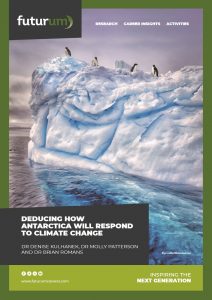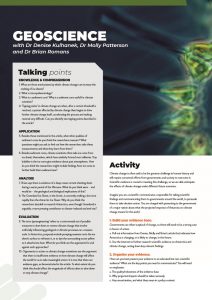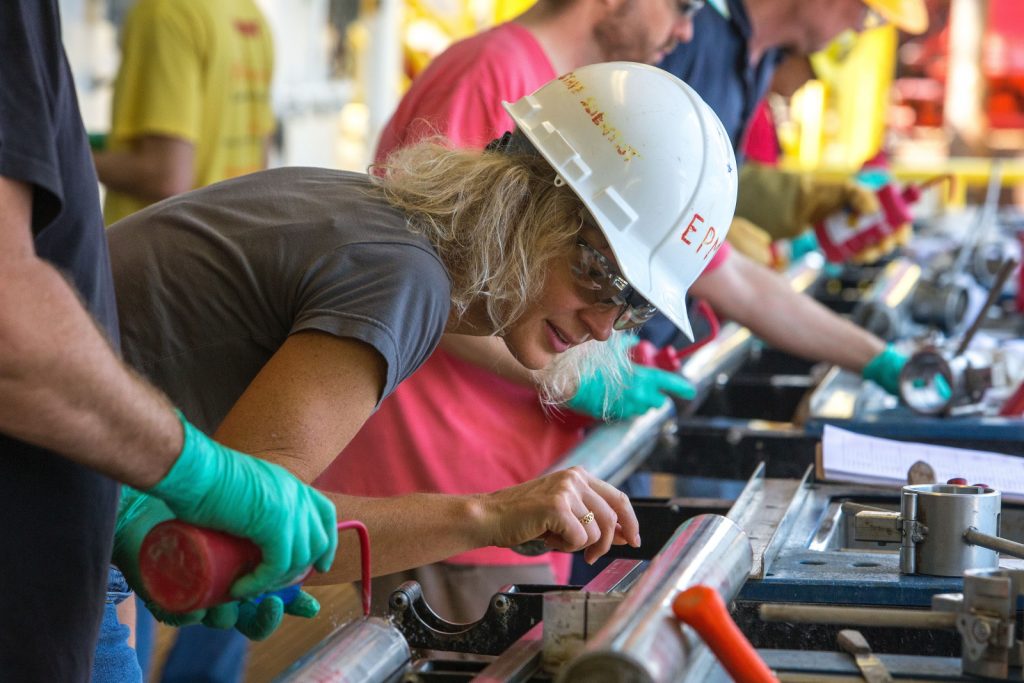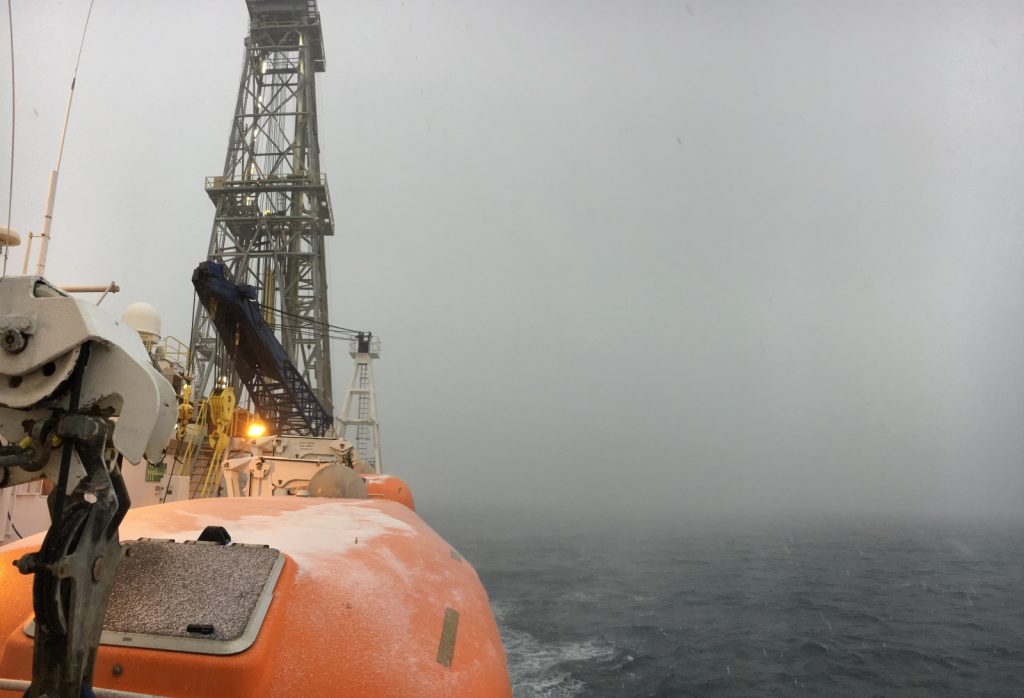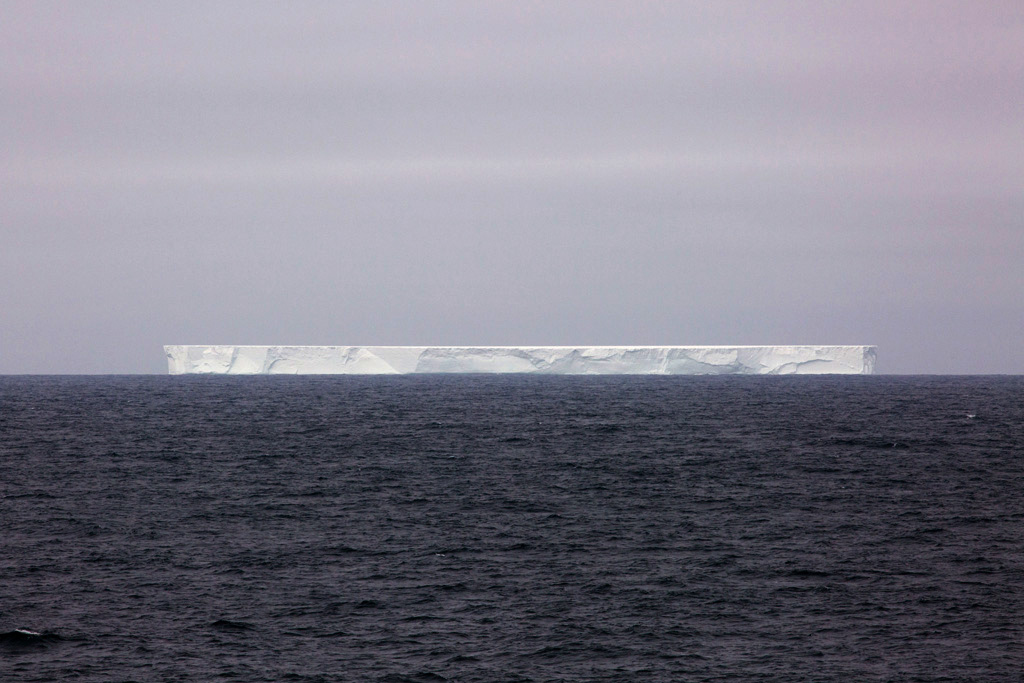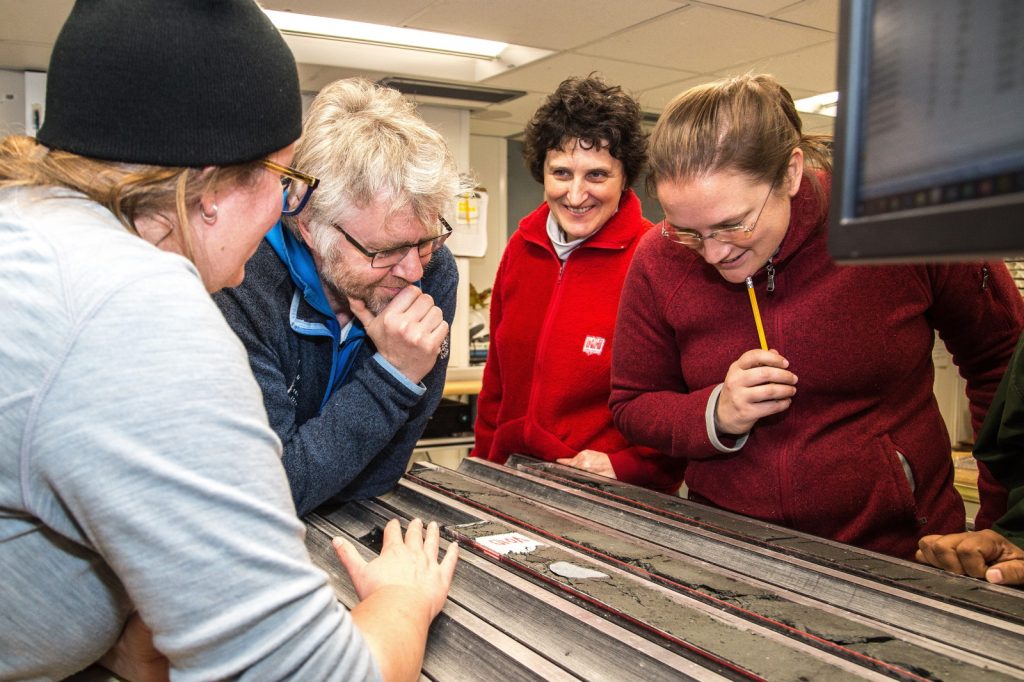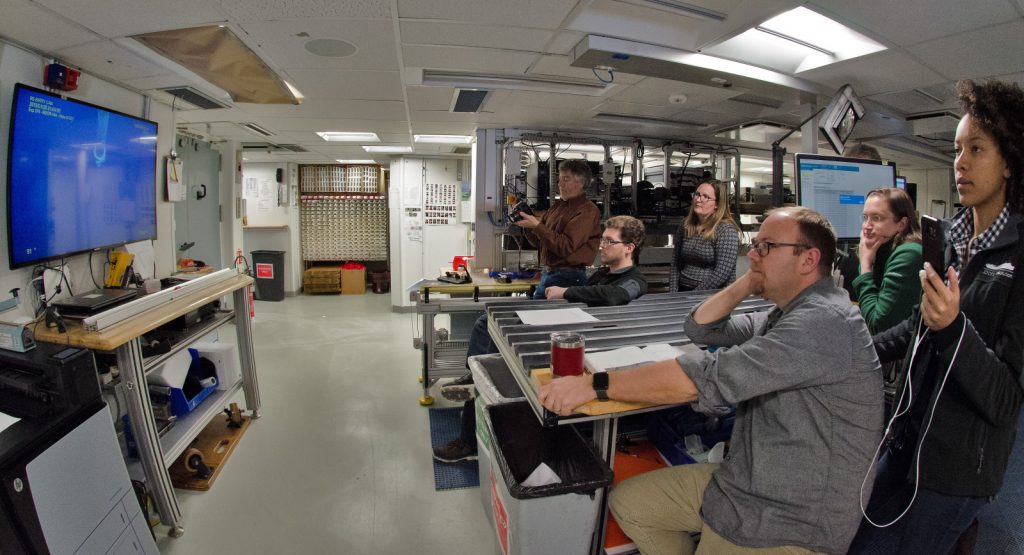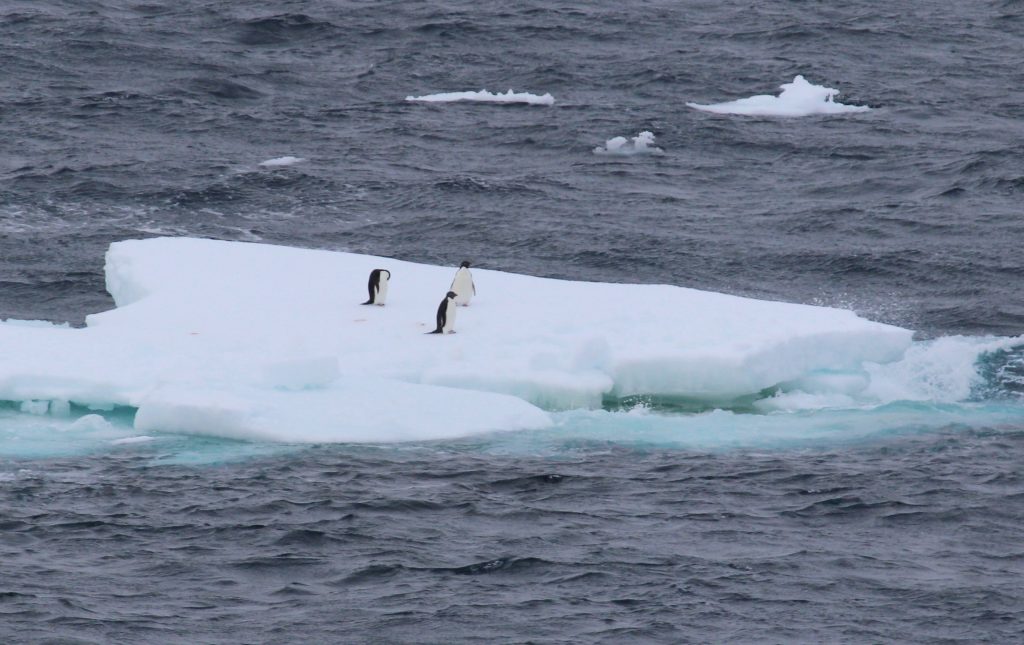Deducing how Antarctica will respond to climate change
Antarctica holds a huge volume of ice – enough to raise global sea levels by 65 metres if it all melted. This means it is vitally important to understand how the Antarctic Ice Sheet is likely to be affected by rising global temperatures. Dr Denise Kulhanek, at the Christian-Albrechts-University of Kiel in Germany, Dr Brian Romans, at Virginia Tech in the US, and Dr Molly Patterson, from Binghamton University in the US, are collaborating to make these predictions by delving deep into Antarctica’s geological past.
TALK LIKE A GEOSCIENTIST
Albedo — the proportion of light that is reflected by a surface
Computerised tomography (CT) scanner — a device (used in medicine as well as research) that uses X-rays to create images of the insides of something
Geoscience — the study of the Earth’s structure and composition, its history and its systems
Ice sheet — a huge mass of ice covering a large area of land or ocean
Micropalaeontology — the study of microscopic fossils
Phytoplankton — plankton that photosynthesise, mostly single-celled plants
Plankton — tiny organisms that drift in the sea or freshwater
Orbital forcing — the effect on the Earth’s climate as the planet changes the tilt of its axis and the shape of its orbit around the Sun
Sediment — material that collects on the land or in the sea, often over millennia. In this case, the team studies sediments deposited on the seafloor
Sediment core — a long, vertical sample of sediment
Historians look to the past to help understand our present and future. This is true not just for human history, but also geological history. We are living through a time of rapid climatic change, but it is no easy task to work out what this means for the processes that underpin our planet. Through examining the geological record, scientists can look to previous times in the Earth’s history where the climate changed, to help make predictions about the changes we are likely to see in coming decades.
“Even though past climate events are not exactly the same as today’s situation, we can still learn a lot by studying how Earth systems responded to change in the past,” says Dr Brian Romans from Virginia Tech. “You can think of our planet’s history as a set of countless ‘experiments’ run by nature that we can compare to present and future conditions.”
In the context of climate change, a lot of research focuses on the Pliocene epoch, from 5 to 2.6 million years ago, which was the last time the atmosphere held similar levels of CO2 to today. “The environmental conditions of the late Pliocene provide a geological analogue to current projected atmospheric CO2 levels and global mean temperatures,” explains Dr Molly Patterson from Binghamton University. These historic conditions were primarily driven by a process called orbital forcing, which is when changes in the tilt of the Earth’s axis and its orbit around the Sun have effects on the climate. This process happens very gradually (over tens of thousands of years), in stark contrast to the rapid climatic changes being driven by human actions today, but nonetheless provides a useful comparison point.
The Antarctic Ice Sheet
The research team is looking at the Antarctic Ice Sheet, which, due to its massive size, has a significant influence on the world’s current climate. “The Antarctic Ice Sheet controls ocean currents and atmospheric circulation, and we are already seeing changes to these systems as melting occurs,” says Dr Denise Kulhanek from Christian-Albrechts-University of Kiel. “It also holds a huge amount of water, so even if a small amount of it melted, it would have drastic impacts on low-lying areas around the world.” The ice sheet has covered the continent of Antarctica for 34 million years – since a long time before the Pliocene – and the team is interested in understanding how it has responded to climatic changes since it first formed.
While a relatively straightforward relationship between climate and ice might be imagined, as higher temperatures lead to more melting, the reality is far more complex. “There are many processes that contribute to ice sheet melt,” says Denise. “One process we are looking at is how the warming of waters surrounding Antarctica can melt the ice sheet from the bottom up.” Other processes include direct melting from the Sun’s energy hitting the ice’s surface. Given that this energy varies daily and seasonally, the ice can undergo repetitive freezing and thawing, which can crack the ice sheet and lead to dramatic collapses of sections. “Additionally, particles such as soot can land on the ice and reduce its albedo,” says Denise. “As the ice becomes darker in colour, it absorbs more energy, causing more melting.” On the global scale, water has a much lower albedo than ice, meaning that the more ice that melts, the more energy is absorbed, creating an accelerating effect.
Filling knowledge gaps
“While we know, generally, that a warming climate leads to ice sheet melting, it’s difficult to predict how fast this will happen,” says Brian. “Will it take decades, centuries or millennia?” Uncovering this relationship involves some sophisticated modelling. “Because these processes typically take place over very long timescales, we have to rely on models by expressing these processes as mathematical formulas,” explains Denise. “To test these models, we compare them with geological records, and then calibrate the models accordingly.” Currently, these geological records are far from complete, so filling in these knowledge gaps is an essential task in order to develop more accurate models – which is exactly what the team is working on.
The team is focusing on an area of Antarctica known as the Ross Sea, which is particularly sensitive to climate changes. “We’re investigating how this part of the ice sheet responded to the relatively warmer climate of the Pliocene, especially the interactions between the ice sheet and ocean currents,” explains Brian. “Changes in ocean currents can bring warmer water into contact with the ice, which can accelerate melting.” Molly is working on comparing the team’s findings to results from an adjacent area of Antarctica, to understand how different parts of the ice sheet respond to climate change. “I aim to find out the most important natural mechanisms that drove ice sheet instability during the Pliocene, and use these findings to make projections about likely instabilities in coming decades and centuries,” she says.
Techniques
A lot of evidence about the Earth’s past can be extracted from sediment cores. Over millennia, sediment builds up on the seafloor, capturing bits of evidence, such as different chemical compositions and microscopic fossils, that give an insight into past environments. In particular, the team is interested in using sediment cores to examine the extent of the ice sheet at different times. “When the ice sheet advances, it bulldozes the sediment, leading to unconformities in sediment cores – ‘missing time’, in other words,” says Denise. “We can compare sediment cores collected at different sites to see where these gaps occur, and we then know when the ice sheet was present in a certain area throughout its history.”
Prior to the team’s efforts, there were very few cores taken from the Ross Sea. “The cores were taken from specific places and at different water depths, to get the most complete records of past ocean-ice sheet interaction,” says Brian. “In particular, they give us information on globally important deep ocean currents, and how these currents affected the ice sheet.” PhD student Natalia Varela is studying these cores using an instrument called a laser particle analyser to accurately determine the size of tiny particles within the sediment cores. The current affects the size of deposited particles as well as other characteristics, so measuring these means that the strength of the current over time can be extrapolated.
Denise’s work focuses on the fossils of marine plankton within sediment cores, which can be examined under a microscope to yield a wide variety of important information. “They can be used to date samples, given that different species have evolved or died out over time,” says Denise. “They also give us information about water conditions, since different plankton species prefer different temperatures, nutrient levels or salinities.” Denise also uses geochemical techniques, especially X-ray fluorescence scanning, a non-destructive method that uses X-rays to determine the elements present within the sediment.
Reference
https://doi.org/10.33424/FUTURUM388


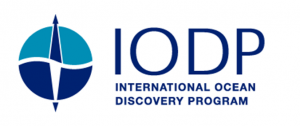




What comes next?
Each laboratory within the project is collecting different datasets that will ultimately be pulled together into a final product. “We have different equipment available to us,” says Denise. “For instance, I had access to a CT scanner to scan the cores, while Molly’s lab has equipment to study grain size and X-ray diffraction.” Molly also has expertise in statistical analysis, a big asset to the team, while Brian and Natalia have skills in reconstructing ocean current behaviour.
Brian and Natalia have found that deep-ocean currents were more active in the warmer Pliocene, relative to the cooler climate that followed. “This result is interesting as it tells us that this type of ocean circulation was still happening when it was warmer,” says Brian. “However, our results also indicate an unusually warm episode when the ocean current shut down abruptly.” This implies there may be a ‘threshold’ temperature, which once exceeded, leads to the current disintegrating – important information for predicting our climate future.
The next step is to combine this finding with the evidence being gathered by Denise and Molly, and their teams. “We are working to combine data from sediment cores on sediment grain sizes, geochemistry and other properties,” says Denise. “Once we have this complete dataset, we can divide the sediment into different ‘packages’ with similar characteristics, helping us pair them up with the broader processes that led to their formation.” For instance, sediment properties such as a yellow colour, high silica concentrations, and low concentrations of magnetisable minerals generally correlate with high concentrations of certain phytoplankton species. “A high productivity of phytoplankton in the surface water above a sediment suggests the area was not covered by thick ice, as they need access to sunlight to photosynthesise,” explains Denise. “We can interpret this as a potentially warmer interval in geological time.” Collating all these data will form a strong foundation of evidence, allowing us to learn more about past climates and the future of our own.
 Dr Denise Kulhanek
Dr Denise Kulhanek
Professor of Marine Micropalaeontology, Institute of Geosciences, Christian-Albrechts-University of Kiel, Germany
Affiliated with Texas A&M University and Binghamton University, USA
Field of research: Marine Micropalaeontology
Dr Molly Patterson
Assistant Professor, Department of Geological Sciences and Environmental Studies, Binghamton University, SUNY, USA
Field of research: Geology
Dr Brian Romans
Associate Professor of Sedimentary Geoscience, Virginia Tech, USA
Field of research: Geology
Joint research project: Studying the behaviour of the Antarctic Ice Sheet under past climates, especially through analysis of the microscopic fossils, composition and geochemistry of the sediment from sediment cores
Funder: US National Science Foundation (NSF)
About marine micropalaeontology
Micropalaeontology is the study of past organisms’ microscopic remains. When we think of fossils, it is dinosaurs and other large animals that spring to mind first, but, in fact, the vast majority of fossils are tiny organisms not visible to the naked eye. Studying these microfossils can tell us a lot about the Earth’s past. As well as a window into past biodiversity, they provide clues about past climates and more local environmental qualities.
Our oceans are filled with phytoplankton: microscopic marine algae that use carbon dioxide to produce oxygen, in much the same way as the plants we find on land. “There is an emerging area of research into how changes in atmospheric CO2 affect phytoplankton,” says Denise. “This is important to understand because as phytoplankton absorb carbon themselves, they in turn affect the climate, so changes in their populations could mitigate or accelerate climate change.”
Once again, turning to the fossil record can help us understand this relationship. “Phytoplankton produce organic molecules that can be preserved in the fossil record,” says Denise. “Some of these can be used to understand past climate, because their composition changes as ocean temperature or atmospheric CO2 changes.” There are growing opportunities to learn more about these molecules and what they can tell us about the past and future.
Denise works closely with many scientists, to share resources and expertise and, ultimately, to produce cohesive research. “Collaboration is one of the best things about science!” she says. “I used to hate group projects at school, but, as a research scientist, I have realised the importance of working together.” Because Denise is on a different continent to Brian and Molly, such collaborative efforts are not necessarily straightforward. “We use online tools like video calls and live documents, which we all became experts at using during the pandemic,” she says. “We also have to take time differences into account, not to mention the changing circumstances and commitments of team members. The main thing is to stay in touch and be supportive.”
Meet Denise
When I started university, I wanted to be an archaeologist. I always really liked history and learning about past cultures, as well as the Indiana Jones movies! During my first semester, I took a physical geology class and loved it. I followed with a class in historical geology, which taught both the physical evolution of the Earth’s continents, as well as the evolution of different organisms. The professor was an amazing educator, and the subject matter was fascinating. I was hooked and changed my major to geology.
Even after finishing my undergraduate degree, I didn’t really know what I wanted to do. I took a master’s degree examining how tiny plankton evolved following the mass extinction event that killed the non-avian dinosaurs, which was fascinating. I then got an internship and, later, a job in the oil industry, which uses micropalaeontology to determine the age of rocks in oil wells. While the work was enjoyable, I didn’t like the industry, and I missed research and teaching, so I quit and took on a PhD, including participating on two research cruises, the second to Antarctica. I really enjoyed sailing and carried on working with these expeditions as a staff scientist for eight years. I then secured a professor position in Germany, which is where I am now.
Curiosity about the natural world and how it works is crucial for scientific success. I am also detail-oriented and organised (at least in my professional life!), which helps with conducting and writing up experiments. I am quite a perfectionist, which can actually be an issue sometimes. Often, it’s best to just get on with a task rather than worrying if it will be perfect.
There are many things that I love about being at sea for research. Whenever we bring up a new core, we are the first people to ever see it, and we often get surprises and learn interesting things about past climates. I also enjoy the peace and simplicity of these expeditions, free from commutes, chores and the regular annoyances of adult life. While we work a lot, it’s free from distractions. Watching marine life and the sea itself is also wonderful.
Being offered my professorship was a proud moment for me. I’m very excited to now train the next generation of marine micropalaeontologists, as well as focus on research.
Denise’s top tip
If you love science, don’t give up on pursuing it as a career, even if you don’t feel your grades are good enough. I know many brilliant scientists who were not the best students in their younger days. Even if you don’t immediately go to university, there are alternative paths you can take to ultimately pursue a graduate degree.
Explore careers in micropalaeontology
• Texas A&M University has a wide array of outreach activities aimed at high school students, ranging from science summer camps, olympiads and roadshows.
• Denise points towards The Micropalaeontological Society, which focuses on public education. Explore its site and learn more about relevant groups around the world.
Pathway from school to micropalaeontology
Denise recommends maths and science subjects as essential for a scientific career. “For a geoscience degree, you will generally need a good understanding of chemistry and physics, as well as calculus,” she says. “I personally wish I had taken more biology courses as an undergraduate, which while not necessarily required, will help you to understand the biological processes that interact with our climate.”
About geology
Geology is the study of the Earth’s structure, evolution and dynamics, as well as the resources it holds. This makes it a very broad field, stretching from minerals to climate, from volcanoes to oceans.
Brian sees a full and exciting future for geology. “There’s a lot to do,” he says. “I think the next generation of geoscientists will be able to learn even more about our planet, through creating new ways to combine and analyse the huge amounts of data that already exist.”
Brian and Molly both believe that embracing data science skills will unlock answers to big questions. “Being able to manipulate and analyse large datasets is going to be increasingly important,” says Molly. “Learning statistical techniques and programming languages are becoming as fundamental as traditional topics such as mineralogy and structural geology.”
Like any area of science, collaboration is of vital importance in geology, especially when tackling pressing issues like climate change. “Just like a detective needs to build their case with multiple pieces of evidence, climate scientists need to generate a range of datasets representing different Earth processes to reveal the whole story,” says Brian. “Different specialties are needed for this – no single person knows everything! While team projects bring challenges, such as communication barriers, the rewards are worth it.”
To get into marine geoscience, Brian has a couple of book recommendations: Soundings: The Story of the Remarkable Woman Who Mapped the Ocean Floor by Hali Felt, and Vanished Ocean: How Tethys Reshaped the World by Dorrik Stow. “I recommend soaking up as much information on your own as you can,” he says. “These books are good starting points, and there are many more out there depending on your specific interests.”
Pathway from school to geology
Brian says that the fundamental sciences of physics, chemistry and biology are important, as geology involves the combination of all three and understanding how processes between them interact. He and Molly agree that mathematical skills, especially statistics and coding, are also very helpful.
Explore careers in geology
• The Time Scavengers site provides a wealth of resources about the connections between fossils and climate, pioneering research in the field, and links to educational opportunities.
• Virginia Tech’s Department of Geosciences has its own museum, which hosts an array of outreach and education events, as well as a fascinating geological collection.
• According to the US Bureau of Labor Statistics, the average salary for geoscientists is around $85,000.
Meet Molly
The mentorship I have received throughout my academic education has been hugely influential for me. I am so grateful to all my mentors and the opportunities they have provided. They are people I consider not just outstanding scientists, but also very kind individuals.
Perceived failures have motivated me to learn and improve next time. This includes harsh paper reviews, failed research grants, or opportunities missed. I also really enjoy listening to different perspectives and working towards solutions on a challenge.
I’ve had a number of career highlights so far. Going on expeditions as a research scientist, collaborating on influential projects, and being named a Co-Chief Scientist on the SWAIS 2C project, which will also examine projected impacts of future climate change on Antarctica, are some of my favourites.
Meet Brian
I received an undergraduate degree in geology and did okay, but I didn’t really know where to go next. I ended up working in the oil industry and quickly realised that I would need a graduate degree to work on more interesting things. My master’s degree and PhD both involved a lot of fieldwork, and I fell in love with sedimentary geology as a field of study.
Going to sea is a different type of fieldwork but is still about discovery. I’ll be going on my third expedition (to Greenland) soon. I love the idea that the deceptively simple observations and measurements that we make can tell us so much about our planet’s history.
Curiosity is a key attribute for any scientist. In my opinion, you need to be genuinely curious and interested in scientific problems to make progress. I’ve seen plenty of smart people who simply weren’t interested in their work, which made it challenging for them to advance. Follow what you’re curious about and acknowledge that this may change over time.
There is bad advice out there. One piece I hear sometimes is that you should seek to work with the most successful and accomplished people, even if they are unkind and the work is unenjoyable. I’m so glad I didn’t follow this advice. Instead, I’ve decided to work with people who are honest and kind. Life is too short to work with jerks, no matter how successful and famous they are!
My proudest moments come from watching my students succeed. Seeing graduate students who I have mentored and advised complete successful projects, and move on to do what they love, makes me very happy.
Brian’s top tip
Be curious about how the world works. Kids have a natural curiosity and a scientific way of thinking, but this can sometimes be lost with the perception that science is just about memorising facts. If you stick with it, you will find that the feeling of discovery and experimentation will return.
Do you have a question for Denise, Molly or Brian?
Write it in the comments box below and Denise, Molly or Brian will get back to you. (Remember, researchers are very busy people, so you may have to wait a few days.)

